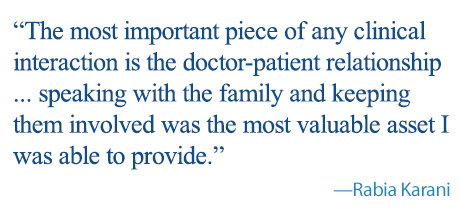As the population of elderly people in our country grows, and as air travel becomes more accessible, medical professionals will be increasingly faced with emergencies in the air. During medical school, students are given some preparation for these situations should they arise: for example on my third-year ob/gyn rotation, we received a lecture on how to deliver a baby on an airplane, and during our fourth year, a lecture on handling medical emergencies in the air. However, as I learned when recently confronted with a medical emergency during a flight, it is really the ability to think quickly and adapt to the resources at hand that allows you to best deal with such situations. As providers, it is sometimes easy to forget to take a step back and appreciate medicine as a profession founded on the basic principle of helping those in need, and these situations often serve as reminders of this concept.
I had never felt less prepared to talk to a patient in my life. I was running on two hours of sleep and had been out of my clinical rotations for almost 10 months; however, when someone called out for a doctor and no one moved, I stood up, knowing that a little knowledge and experience are better than none. When I reached the patient, he was completely unresponsive to the screams of his terrified wife. His head was tilted back, his jaw was slack and his eyes were rolled back into his head. Almost thirty seconds after I reached him, his eyes re-focused, and he regained consciousness, with no memory of the event. His wife explained that he had done the same thing two minutes before, which had prompted her initial cries for help.
Completely on my own to care for the patient, I performed a quick exam, took a history, managed to collect his vital signs and calmed down his terrified family and the panicked flight attendants. The flight attendants kept asking me whether they should land the plane, an enormous decision to make as a medical student, but thankfully one I did not have to make alone, due to the arrival of a family practice physician who had been at the front of the plane and had not heard what was happening. Together, we tended to the family for nearly an hour, and for the remainder of the flight, everyone from passengers to the captain thanked me, ending the flight by clapping for “the medical student.”

This experience brought me back to the basics of medicine. In a situation with very limited resources, I revisited what patients really expect from their medical provider. The most important piece of any clinical interaction is the doctor-patient relationship, and on this flight, speaking with the family and keeping them involved was the most valuable asset I was able to provide. By maintaining a calm presence, and simply being there for the patient and his family, I was able to offer them some peace of mind until the flight touched the ground. This experience was one that truly humbled me, because it was yet another reminder of how fulfilling medicine can be. In the face of difficulty, you can offer people a shred of hope as a provider, and in the face of fear, you can offer them a soothing smile, a calm voice and the presence of someone who is there in a time of need.
Related Content
- Read: Check out more stories about the daily lives of our trainees.
- Read: Meaningful Interactions Build Trust with Patients Online

Pingback: Inside a Med Student’s Mind On a Patient Visit
Comments are closed.